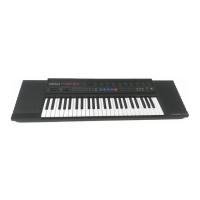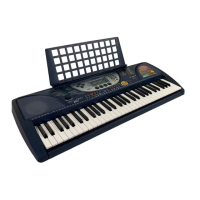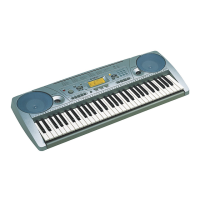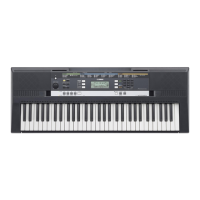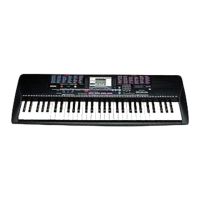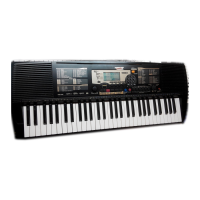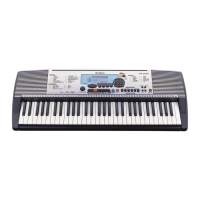Do you have a question about the Yamaha PSR-273 and is the answer not in the manual?
Information believed correct at printing; Yamaha reserves right to change specifications without notice.
Yamaha strives for user-safe, environmentally friendly products and compliance with laws.
Notice on using rechargeable batteries, mixing, and warnings regarding battery safety.
Observe regulations for product disposal containing lead, batteries, and plastics.
Location of name plate for model, serial, power requirements, and purchase date recording.
Modifications not expressly approved by FCC may void authority to use the product.
Use only high quality shielded cables; follow installation instructions to avoid voiding FCC authorization.
Product tested and found compliant with FCC Part 15 for Class "B" digital devices, ensuring reasonable interference levels.
Essential warnings for safe operation, including power, water, fire, and abnormalities.
Guidelines for safe handling, placement, battery use, and disposal.
Special grand piano voice using AWM stereo sampling technology.
Natural touch response with front panel switch; works with dynamic filter.
Learning tools using modern technology for fun study and practice.
Automatically activates appropriate voice for selected style/song.
Ensures GM-compatible data is interpreted correctly by GM tone generators.
Simplified version of XG format for high-quality tone generation.
Overview of all front panel buttons and their functions.
Overview of rear panel connections for power, audio, MIDI, and pedal.
Recommends AC adapter over batteries for environmental and resource reasons.
Steps for connecting the AC adapter to the instrument and power outlet.
Instructions for installing six "D" size batteries.
How to select and play voices, and use the metronome.
How to select the Grand Piano voice and use the metronome feature.
How to play demo songs and individual songs.
How to play demo and individual songs, including playback controls.
How to use styles for accompaniment and play melodies.
Explains how styles provide a professional instrumental background.
How to adjust the master volume using the dial.
Shows the currently selected song, style, or voice number and name.
How to access and adjust various function settings.
Explains various indicators on the LCD screen like notation, measure, beat, etc.
Selects "Stereo Sampled Piano" voice by pressing PORTABLE GRAND.
How to activate and adjust the metronome tempo.
How to select and play a voice using the VOICE button.
Combines two voices in a layer; adjustable parameters like volume, octave.
Assigns two voices to different keyboard sections for split playing.
Provides dynamic control over voice volume based on playing pressure.
Adds performance effects to melodies when using accompaniment styles.
Reproduces natural ambience of performance spaces like concert halls.
Enhances voices with pitch modulation (Chorus/Flanger).
Adds a slow, natural decrease in voice volume when keys are released.
How to select styles from the 100 available patterns.
Explains panel buttons for style control (ACMP ON/OFF, Sync Start, etc.).
How to start a style using START/STOP or selecting sections like Main A/B.
How to change chords and hear accompaniment change.
How to play major, minor, 7th, and minor 7th chords with single finger.
Shows chord types recognized in Fingered mode.
How to activate the chord dictionary function.
How to specify the root note of the desired chord.
How to specify the chord type (major, minor, 7th, etc.).
How to play the chord indicated on the screen using the dictionary.
How to select a desired song using the SONG button and numeric keys.
Explains panel buttons for song playback control (START/STOP, REW, FF, etc.).
Function to specify a song phrase (A to B) and repeat it for practice.
Allows changing the melody voice of a song to any selected panel voice.
How to select lesson songs and parts for practice.
Practice note synchronization by playing any note in rhythm.
Waits for correct notes before proceeding, allowing practice at own pace.
Practice with both parts silenced, playing along with notation.
Explains MIDI as a digital interface for musical instruments.
How to connect the keyboard to a PC via MIDI interface or USB.
Enable/disable keyboard control of PSR-275/273 voices for MIDI sequencing.
Control playback by external MIDI clock or internal clock.
How to select and adjust various function parameters.
Detailed table of function parameters, settings, and descriptions.
Lists common problems and their possible causes and solutions.
Details of voice lists including polyphony and panel voice data.
Lists XGlite, Synth Effects, and Sound Effects voices with MIDI numbers.
Lists all 100 styles by category and name.
Lists drum kit sounds and their keyboard assignments.
Comprehensive chart detailing MIDI messages transmitted and recognized by the PSR-275/273.
Maps effect types to LSB values for Reverb and Chorus effects.
Technical specifications of the PSR-275/273 keyboard.
Yamaha contact information for the Americas.
Yamaha contact information for Europe and Asia.
Yamaha contact information for Oceania and other Pacific territories.
Information believed correct at printing; Yamaha reserves right to change specifications without notice.
Yamaha strives for user-safe, environmentally friendly products and compliance with laws.
Notice on using rechargeable batteries, mixing, and warnings regarding battery safety.
Observe regulations for product disposal containing lead, batteries, and plastics.
Location of name plate for model, serial, power requirements, and purchase date recording.
Modifications not expressly approved by FCC may void authority to use the product.
Use only high quality shielded cables; follow installation instructions to avoid voiding FCC authorization.
Product tested and found compliant with FCC Part 15 for Class "B" digital devices, ensuring reasonable interference levels.
Essential warnings for safe operation, including power, water, fire, and abnormalities.
Guidelines for safe handling, placement, battery use, and disposal.
Special grand piano voice using AWM stereo sampling technology.
Natural touch response with front panel switch; works with dynamic filter.
Learning tools using modern technology for fun study and practice.
Automatically activates appropriate voice for selected style/song.
Ensures GM-compatible data is interpreted correctly by GM tone generators.
Simplified version of XG format for high-quality tone generation.
Overview of all front panel buttons and their functions.
Overview of rear panel connections for power, audio, MIDI, and pedal.
Recommends AC adapter over batteries for environmental and resource reasons.
Steps for connecting the AC adapter to the instrument and power outlet.
Instructions for installing six "D" size batteries.
How to select and play voices, and use the metronome.
How to select the Grand Piano voice and use the metronome feature.
How to play demo songs and individual songs.
How to play demo and individual songs, including playback controls.
How to use styles for accompaniment and play melodies.
Explains how styles provide a professional instrumental background.
How to adjust the master volume using the dial.
Shows the currently selected song, style, or voice number and name.
How to access and adjust various function settings.
Explains various indicators on the LCD screen like notation, measure, beat, etc.
Selects "Stereo Sampled Piano" voice by pressing PORTABLE GRAND.
How to activate and adjust the metronome tempo.
How to select and play a voice using the VOICE button.
Combines two voices in a layer; adjustable parameters like volume, octave.
Assigns two voices to different keyboard sections for split playing.
Provides dynamic control over voice volume based on playing pressure.
Adds performance effects to melodies when using accompaniment styles.
Reproduces natural ambience of performance spaces like concert halls.
Enhances voices with pitch modulation (Chorus/Flanger).
Adds a slow, natural decrease in voice volume when keys are released.
How to select styles from the 100 available patterns.
Explains panel buttons for style control (ACMP ON/OFF, Sync Start, etc.).
How to start a style using START/STOP or selecting sections like Main A/B.
How to change chords and hear accompaniment change.
How to play major, minor, 7th, and minor 7th chords with single finger.
Shows chord types recognized in Fingered mode.
How to activate the chord dictionary function.
How to specify the root note of the desired chord.
How to specify the chord type (major, minor, 7th, etc.).
How to play the chord indicated on the screen using the dictionary.
How to select a desired song using the SONG button and numeric keys.
Explains panel buttons for song playback control (START/STOP, REW, FF, etc.).
Function to specify a song phrase (A to B) and repeat it for practice.
Allows changing the melody voice of a song to any selected panel voice.
How to select lesson songs and parts for practice.
Practice note synchronization by playing any note in rhythm.
Waits for correct notes before proceeding, allowing practice at own pace.
Practice with both parts silenced, playing along with notation.
Explains MIDI as a digital interface for musical instruments.
How to connect the keyboard to a PC via MIDI interface or USB.
Enable/disable keyboard control of PSR-275/273 voices for MIDI sequencing.
Control playback by external MIDI clock or internal clock.
How to select and adjust various function parameters.
Detailed table of function parameters, settings, and descriptions.
Lists common problems and their possible causes and solutions.
Details of voice lists including polyphony and panel voice data.
Lists XGlite, Synth Effects, and Sound Effects voices with MIDI numbers.
Lists all 100 styles by category and name.
Lists drum kit sounds and their keyboard assignments.
Comprehensive chart detailing MIDI messages transmitted and recognized by the PSR-275/273.
Maps effect types to LSB values for Reverb and Chorus effects.
Technical specifications of the PSR-275/273 keyboard.
Yamaha contact information for the Americas.
Yamaha contact information for Europe and Asia.
Yamaha contact information for Oceania and other Pacific territories.
| Type | Portable Keyboard |
|---|---|
| Number of Keys | 61 |
| Touch Sensitivity | No |
| Polyphony | 32 |
| Number of Voices | 100 |
| Number of Styles | 100 |
| Effects | Reverb, Chorus |
| Display | LCD |
| Lesson Function | Yes |
| Amplifier | 5W |
| Power Supply | AC adapter or batteries |
| Connectors | Headphone, Sustain Pedal |

